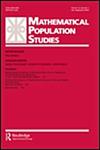Keeping random walks safe from extinction and overpopulation in the presence of life-taking disasters
IF 1.3
3区 社会学
Q3 DEMOGRAPHY
引用次数: 2
Abstract
ABSTRACT Recurrence and transience conditions are made explicit in discrete-time Markov chain population models for which random stationary growth alternates with disastrous random life-taking events. These events either have moderate stationary magnitudes or lead to an abrupt population decline. The probability of their occurrence may or may not depend on the population size. These conditions are based on the existence or not of a “weak” carrying capacity, where “weak” means that the carrying capacity can be exceeded, temporarily. In this framework, the population is threatened with extinction, an event whose probability is expressed, as well as the law of the time remaining until this deadline. On the other hand, the population is also threatened by overpopulation, an event whose time to reach a given threshold is expressed, as well as the difference between the population size and the carrying capacity. The theory is that of extreme values for Markov chains and is based on the control of the spectral properties of the northwest truncation of the transition matrix of the original Markov chain with life-taking disasters. The article presents an extension to the case where the process of life-taking disasters is no longer geometric and to the case where the probability of occurrence of a disaster depends on the population size. Both the time to extinction and the time to a given threshold have geometrically decaying distribution tails. The use of the extremal Markov chain in the calculation of the time to overpopulation is innovative.在发生夺走生命的灾难时,保持随机行走的安全,避免灭绝和人口过剩
摘要在离散时间马尔可夫链种群模型中,明确了随机平稳增长与灾难性随机夺命事件交替的递归和瞬态条件。这些事件要么具有中等的平稳幅度,要么导致人口急剧下降。它们发生的概率可能取决于人口规模,也可能不取决于人口数量。这些条件是基于是否存在“弱”承载能力,其中“弱”意味着可以暂时超过承载能力。在这个框架下,种群面临灭绝的威胁,这一事件的概率以及截止日期前的剩余时间定律都得到了表达。另一方面,人口也受到人口过剩的威胁,人口过剩是一种达到给定阈值的时间,以及人口规模和承载能力之间的差异。该理论是马尔可夫链的极值理论,基于对具有致命灾难的原始马尔可夫链的转移矩阵的西北截断的谱性质的控制。这篇文章扩展了夺走生命的灾难过程不再是几何的情况,以及灾难发生的概率取决于人口规模的情况。到灭绝的时间和到给定阈值的时间都具有几何衰减的分布尾。在计算人口过剩的时间时使用极端马尔可夫链是创新的。
本文章由计算机程序翻译,如有差异,请以英文原文为准。
求助全文
约1分钟内获得全文
求助全文
来源期刊

Mathematical Population Studies
数学-数学跨学科应用
CiteScore
3.20
自引率
11.10%
发文量
7
审稿时长
>12 weeks
期刊介绍:
Mathematical Population Studies publishes carefully selected research papers in the mathematical and statistical study of populations. The journal is strongly interdisciplinary and invites contributions by mathematicians, demographers, (bio)statisticians, sociologists, economists, biologists, epidemiologists, actuaries, geographers, and others who are interested in the mathematical formulation of population-related questions.
The scope covers both theoretical and empirical work. Manuscripts should be sent to Manuscript central for review. The editor-in-chief has final say on the suitability for publication.
 求助内容:
求助内容: 应助结果提醒方式:
应助结果提醒方式:


